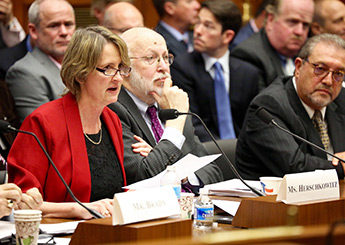Silica rule in the spotlight at House subcommittee hearing

Washington – OSHA’s recently issued final rule on respirable crystalline silica received both criticism and support during an April 19 hearing convened by the House Workforce Protections Subcommittee.
Industry stakeholders argued that compliance with the rule – published on March 24 – will be expensive and impractical. Testifying on behalf of the National Association of Home Builders, Ed Brady, president of Brady Homes Illinois, said the rule “reflects a fundamental lack of understanding of construction and is technologically and economically infeasible.” Brady urged OSHA to revisit the rule and “work with us to create a new rule that protects workers while also balancing the technological and economic challenges in the residential construction sector. If not, he added, “Congress must move swiftly to stop this flawed rule.”
Brady said the rule’s “aggressive compliance regime” of controls in many cases cannot be applied in residential construction. Measuring worker exposure can be challenging, and requirements are “often impractical or impossible,” he added. For example, wet cutting can be impractical indoors and during the winter, and some jobsites may lack water service.
OSHA also underestimated costs of the rule, said Brady, citing an analysis partially funded by NAHB that concluded the annual cost will be $5 billion – not $1 billion as OSHA claims.
The rule decreases the permissible exposure limit to 50 micrograms per cubic meter of air, averaged over an 8-hour shift. Janis Herschkowitz, president of Regal Cast in Lebanon, PA, testified on behalf of the American Foundry Society. Herschkowitz said compliance with the new limits in the foundry industry would be difficult. “Given the day-to-day variation in exposure levels that are typical of foundry operations, that means we have to achieve average levels below 10 µg/m3 to avoid citations for exceeding the PEL,” she noted in her written testimony. “To achieve that dust level we would need to meet standards typical of clean room operations. Foundry processes are simply not capable of achieving those levels of dust control.”
Others at the hearing expressed support for the rule. The previous standard did not completely protect workers from developing diseases, said Dr. James Melius, director of research at the Laborers’ Health and Safety Fund of North America. OSHA estimates that the rule will save more than 600 lives and prevent more than 900 cases of the lung disease silicosis per year.
“Controlling silica dust is a well-understood and time-tested proposition,” Rep. Frederica Wilson (D-FL), the subcommittee’s ranking member, said. “Wet the dust down or vacuum it up.”
Post a comment to this article
Safety+Health welcomes comments that promote respectful dialogue. Please stay on topic. Comments that contain personal attacks, profanity or abusive language – or those aggressively promoting products or services – will be removed. We reserve the right to determine which comments violate our comment policy. (Anonymous comments are welcome; merely skip the “name” field in the comment box. An email address is required but will not be included with your comment.)

